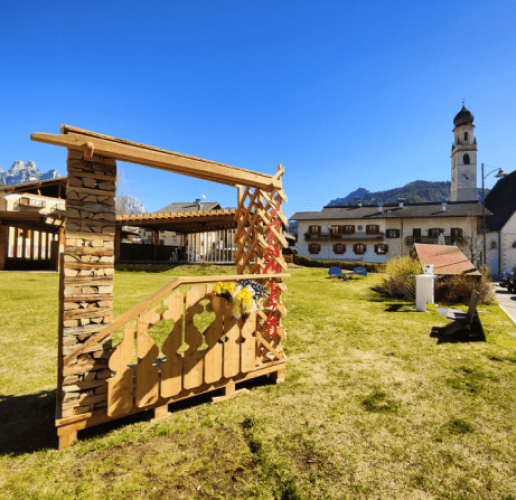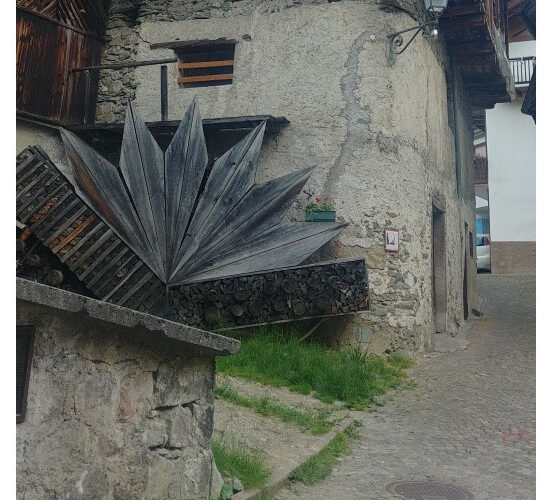The red gateway

If you have not arrived from the car park, this is the first time we have met. So, welcome to Mezzano!
In front of the Town Hall you can see the Church, the first of the wood-stack installations, “The spheres of the imaginary” and the Brolo square. Just by the Town Hall there is quite a large wood-stack installation entitled “In the beginning”. Its touching immediacy is easy to interpret: three men are intent on sawing down a tree, as is and will always be. Cutting down a tree is the beginning of everything, it is with a tree that one makes a roof, a house and fire for the hearth.
Mezzano has a population of about 1600 inhabitants, it is 640 metres above sea level and covers a surface area of 48 square kilometres.
Its name probably derives from its position half way along the valley – from Latin medianus, mediano -, set between Imer – from imus lower -, and Siror – superior – higher. There are also other suppositions on the origin of the name: the De Mezan family that lived here, or land under Roman authority called Mettianus.
The houses of the village are set on a gentle northern slope, crowned by the Pale di San Martino mountains and bordered to the south by the Belluno Dolomites with the pyramidal Mount Pavione.
The discovery of worked flints nearby the Colbricon lakes confirms the presence of nomad hunters. Already in the Mesolithic period, about 7000 years ago, they settled in this area in rudimentary hunting encampments. There have been various historical finds in Primiero and when digging up the floor of the Parish Church of Pieve, the foundations of an early Christian church came to light, confirming the theory of a permanent settlement there before the year 1000.
In the beginning the community of Primiero, therefore including Mezzano, was bound to and under the authority of the Bishops of Feltre. In 1373 the entire valley passed under the Tyrolean Counts, to the House of Habsburg, in 1386 it was under the direct control of the Emperor of Austria who in 1401 conceded the fiefdom to the Barons; then to the Welsperg Counts whose dominion lasted up to the end of The First World War.
The bypass was constructed in 2005 and it seriously risked cutting off the village. Live or die? With the critical eye of outsiders analysing the situation objectively, it was recognised that Mezzano had the right cards to play as far as tourism was concerned by focussing with determination on Mezzano’s farming and agricultural past, in what was an overall well-preserved place. From here five key factors were identified: the signs that indicate a rural life and the treasures that have been well maintained: water, vegetable gardens, architecture, frescos and inscriptions.
From here, in a short time, the village became part of the exclusive club “The most beautiful villages of Italy”. The village takes pride in this identity of being an artistic and rural village, where traditions resist, and innovation is embraced as the driving force of development.
In 2010 Mezzano Romantica was launched; it unites within Romanticism places, people and signs that indicate a rural life. It has offered the village a cultural rebirth, hosting international musicians; summer is always exciting with symphonic concerts, operas, musicals and many other shows.
In 2011, as a finishing touch the “Cataste e Canzei” wood-stack installation exhibition was set in motion, a mix of artistic works that adorn different parts of the village. They reflect the skill of villagers who build their wood-stacks so as to ensure an adequate supply of fuel for the winter. Canzel is the dialect term for wood-stack. This original idea, unique in the world, was the brainchild of Ivano Orsingher.
While you walk I will tell you about every one of these features, so you can discover the past life of farming, some of which could become part of you. The pace of life is slower, life is simpler, you can certainly feel nature, the past is an inspiration, the locals all know each other, and they love their land. The locals will recognise you. You only have to look around you, breathe the air, and if you wish, ask. Now is the time. Pass through the gateway and you are within.
Walk along the side of the Town Hall. Can you see the arrow? I will await you there.
























